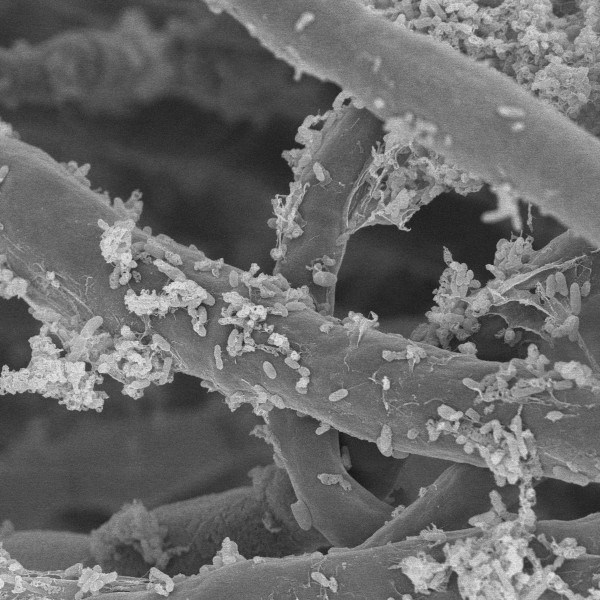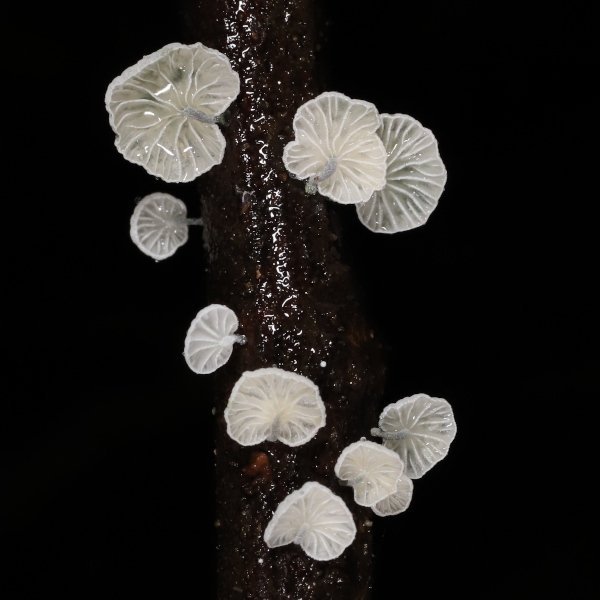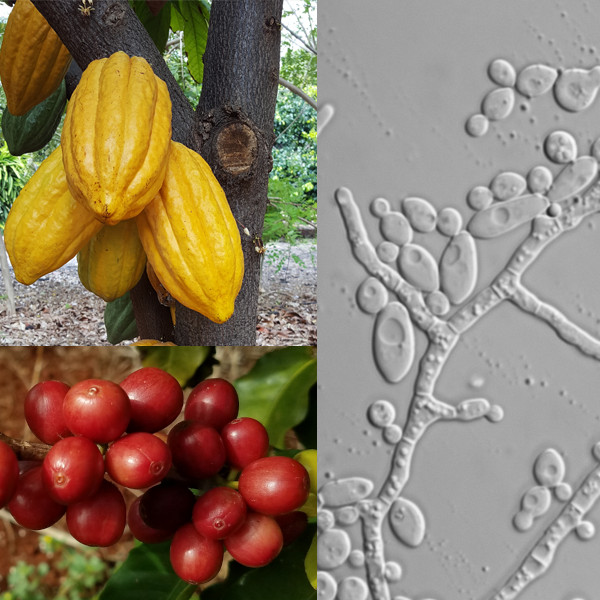

Microbiome interactions at the plant-fungal-soil interface
Fungal-bacterial interactions in the hyphosphere
 The ubiquity and importance of fungal-bacterial interactions is only beginning to be understood and appreciated. Fungi and bacteria are the most diverse and abundant microorganisms in the soil
and the results of their interactions could translate to major consequences across natural, managed, and urban terrestrial ecosystems. We study how fungi and bacteria interact
with each other and determine the functional outcomes of their interactions. Our current research projects examine the fundamental mechanisms driving fungal-bacterial interactions;
how they shape carbon, nitrogen, and phosphorus cycling; responses to drought; determinants of assembly across soil mineralogies; and resistance to antibiotics.
Watch the mass movement of bacteria along a network of fungal highways in real time.
The ubiquity and importance of fungal-bacterial interactions is only beginning to be understood and appreciated. Fungi and bacteria are the most diverse and abundant microorganisms in the soil
and the results of their interactions could translate to major consequences across natural, managed, and urban terrestrial ecosystems. We study how fungi and bacteria interact
with each other and determine the functional outcomes of their interactions. Our current research projects examine the fundamental mechanisms driving fungal-bacterial interactions;
how they shape carbon, nitrogen, and phosphorus cycling; responses to drought; determinants of assembly across soil mineralogies; and resistance to antibiotics.
Watch the mass movement of bacteria along a network of fungal highways in real time.
Papers associated with this project:
Nguyen 2023,
Nuccio et al. 2021,
Yuan et al. 2021,
Nguyen et al. 2015
Soil microbial and nutrient dynamics in agroecosystems
 Plant roots release exudates that stimulate and shape soil microbial communities around them in an area of influence is called the rhizosphere. We study the ways the rhizospheres of cultivated and
wild plant species interact with and change the soil microbiome. This can lead to a mechanistic understanding of the microbial contributions to nutrient cycling, soil health, and plant productivity.
Our current projects examine the mechanisms of how rhizospheres shape their microbial communities; the connection between nutrient dynamics and soil microbes across different land-use and agricultural systems in Hawaiʻi;
carbon and nitrogen dynamics, microbiome, that contributes to the invasive potentials of tropical Guinea grass (Megathyrsus maximus) in Hawaiʻi; and contrasts with the carbon and nitrogen dynamics in wild oats (Avena spp.) in California annual grasslands (see Cross-Kingdom Interactions website).
Plant roots release exudates that stimulate and shape soil microbial communities around them in an area of influence is called the rhizosphere. We study the ways the rhizospheres of cultivated and
wild plant species interact with and change the soil microbiome. This can lead to a mechanistic understanding of the microbial contributions to nutrient cycling, soil health, and plant productivity.
Our current projects examine the mechanisms of how rhizospheres shape their microbial communities; the connection between nutrient dynamics and soil microbes across different land-use and agricultural systems in Hawaiʻi;
carbon and nitrogen dynamics, microbiome, that contributes to the invasive potentials of tropical Guinea grass (Megathyrsus maximus) in Hawaiʻi; and contrasts with the carbon and nitrogen dynamics in wild oats (Avena spp.) in California annual grasslands (see Cross-Kingdom Interactions website).
Papers associated with this project:
Abe et al. 2023,
Dhungana et al. 2023,
Heisey et al. 2022
Soil biodiversity builds Soil Health
 Measuring total soil biodiversity is one of the most basic, yet fundamental quantifications that can contribute towards an integrative measure of soil health. It is generally stated that soil biodiversity matters for proper functioning of a healthy soil,
but we lack the basic understanding of the mechanisms of how soil biodiversity can drive a healthy soil, especially across a diversity of soils and management systems. As a first step to developing a mechanistic understanding of the biological drivers of soil health across these different environments,
we are developing and streamlining molecular tools that will enable rapid identification of soil biodiversity. We collaborate with Dr. Tai Maaz and the Hawaii Soil Health Team
to integrate soil biodiversity data into a more objective way of measuring soil health. Take a peek at some of the soil invertebrates we found.
Measuring total soil biodiversity is one of the most basic, yet fundamental quantifications that can contribute towards an integrative measure of soil health. It is generally stated that soil biodiversity matters for proper functioning of a healthy soil,
but we lack the basic understanding of the mechanisms of how soil biodiversity can drive a healthy soil, especially across a diversity of soils and management systems. As a first step to developing a mechanistic understanding of the biological drivers of soil health across these different environments,
we are developing and streamlining molecular tools that will enable rapid identification of soil biodiversity. We collaborate with Dr. Tai Maaz and the Hawaii Soil Health Team
to integrate soil biodiversity data into a more objective way of measuring soil health. Take a peek at some of the soil invertebrates we found.
Forest soil microbiomes in a changing climate
Suillus, a model for ecology & evolution of plant-fungal mutualisms
 The genus Suillus is an important ectomycorrhizal symbiont of pinaceous trees in many temperate forest ecosystems. The Suillus Consortium established the genus as a powerful and flexible experimental system to study plant-fungal mutualism.
Through collaborations with the Joint Genome Institute, we are sequencing the genomes of more than 50 Suillus species across the genus, as well as over 300 strains of species that occur in introduced habitats around the world. We use genome-enabled 'omics techniques to discover mechanisms of host specificity, host switching,
genomic bottlenecks and expansions since isolation, host protection from heavy metals, interactions with soil organisms and soil organic matter to name a few.
The genus Suillus is an important ectomycorrhizal symbiont of pinaceous trees in many temperate forest ecosystems. The Suillus Consortium established the genus as a powerful and flexible experimental system to study plant-fungal mutualism.
Through collaborations with the Joint Genome Institute, we are sequencing the genomes of more than 50 Suillus species across the genus, as well as over 300 strains of species that occur in introduced habitats around the world. We use genome-enabled 'omics techniques to discover mechanisms of host specificity, host switching,
genomic bottlenecks and expansions since isolation, host protection from heavy metals, interactions with soil organisms and soil organic matter to name a few.
Papers associated with this project:
Lofgren et al. 2024,
Ke et al. 2023,
Erlandson et a. 2021,
Lofgren et al. 2021,
Perez-Pazos et al. 2021,
Bazzicalupo et al. 2020,
Kennedy et al. 2020,
Lofgren et al. 2018,
Branco et al. 2017,
Nguyen et al. 2016,
Nguyen et al. 2015
Microbes, carbon, and tropical soils in a changing climate
 As our global temperatures climb dangerously higher, the impetus to understand the flow of soil carbon and nutrients through soil biological systems become increasingly essential. In collaboration with Dr. Susan Crow, we study microbial potentials to stabilize and destabilize soil organic matter across the broad spatial, minerological, and biological gradients of the Hawaiian Islands.
As our global temperatures climb dangerously higher, the impetus to understand the flow of soil carbon and nutrients through soil biological systems become increasingly essential. In collaboration with Dr. Susan Crow, we study microbial potentials to stabilize and destabilize soil organic matter across the broad spatial, minerological, and biological gradients of the Hawaiian Islands.
Papers associated with this project:
McGrath et al. 2022,
Erlandson et al. 2021
On-going synthesis projects
Macro and micro fungi of Hawaiʻi
 Fungi are one of the most diverse groups of organisms on the planet. Macrofungi (those with conspicuous fruiting bodies such as mushrooms, crusts, and molds) are generally well recorded, but the microfungi (those that are small or microscopic) are much less documented. The goal of this natural history project is to document the occurence of macrofungi and microfungi in Hawaiʻi through specimen vouchers and DNA sequences. Sequence data from our projects in the lab, as well as from other fungal labs in Hawaiʻi contribute to the overall goal of this project.
Fungi are one of the most diverse groups of organisms on the planet. Macrofungi (those with conspicuous fruiting bodies such as mushrooms, crusts, and molds) are generally well recorded, but the microfungi (those that are small or microscopic) are much less documented. The goal of this natural history project is to document the occurence of macrofungi and microfungi in Hawaiʻi through specimen vouchers and DNA sequences. Sequence data from our projects in the lab, as well as from other fungal labs in Hawaiʻi contribute to the overall goal of this project.
Results from this project: Checklist of the Fungi and Slime Molds of Hawaiʻi v1.0
Soil microbiome of the Hawaiian Islands
 The soil is arguably the most complex environment in which to study microbes, and it is this same complexity that leads to the overwhelming diversity of soil microorganisms (speaking broadly including prokaryotes, fungi, and protists). The aim of this project is to catalogue the identity, richness, and genetic diversity of microbial organisms in both agricultural and natural ecosystems across the Hawaiian Islands. The culmination of many current and past lab projects contribute the underlying data for the concept of the Soil Microbiome of the Hawaiian Islands.
The soil is arguably the most complex environment in which to study microbes, and it is this same complexity that leads to the overwhelming diversity of soil microorganisms (speaking broadly including prokaryotes, fungi, and protists). The aim of this project is to catalogue the identity, richness, and genetic diversity of microbial organisms in both agricultural and natural ecosystems across the Hawaiian Islands. The culmination of many current and past lab projects contribute the underlying data for the concept of the Soil Microbiome of the Hawaiian Islands.
Papers associated with this project:
Amend et al. 2022,
Wehr et al. 2019
FUNGuild
 We continuously update our FUNGuild system to assign ecological guilds to fungal taxa. Nhu continues collaboration (as of 2022) with Peter Kennedy, Scott Bates, Zewei Song to maintain and improve the FUNGuild database, adding more entries and improving performance. This system is quickly becoming useful to a wide range of researchers in fungal ecology. Further, we are working to extend the use of the parsing system to other biological groups including nematodes and protists. If you would like to contribute your guild data to improve our databases, please email Nhu.
We continuously update our FUNGuild system to assign ecological guilds to fungal taxa. Nhu continues collaboration (as of 2022) with Peter Kennedy, Scott Bates, Zewei Song to maintain and improve the FUNGuild database, adding more entries and improving performance. This system is quickly becoming useful to a wide range of researchers in fungal ecology. Further, we are working to extend the use of the parsing system to other biological groups including nematodes and protists. If you would like to contribute your guild data to improve our databases, please email Nhu.
Papers associated with this project: Nguyen et al. 2016
Past projects
Microbial fermentations of plant products in Hawaiʻi
 The proper fermentation of cacao and coffee beans is essential to producing quality chocolates and coffees. We study the ways in which natural microbes and microbial communities contribute to different sensory characteristics (flavor, taste, texture) of plant products (in particular cacao and coffee) grown in Hawaiʻi.
Our current work explores different types of local yeasts and their contributions to sensory outcomes of specialty coffees.
The proper fermentation of cacao and coffee beans is essential to producing quality chocolates and coffees. We study the ways in which natural microbes and microbial communities contribute to different sensory characteristics (flavor, taste, texture) of plant products (in particular cacao and coffee) grown in Hawaiʻi.
Our current work explores different types of local yeasts and their contributions to sensory outcomes of specialty coffees.
Papers associated with this project:
Lewis et al. 2023
Nodulating rhizobia in native and non-native legumes
 We know that legume-nodulating rhizobia are common in our soils, but which species of rhizobia associates with native and non-native plants? Can we isolate and use them in native plant restoration efforts? Jon Abe, an undergraduate in the lab created and drove this project to
isolate,
identify, and produce inoculum resources that are available to restoration and agricultural efforts in the state. The UH Mānoa's Undergraduate Research Opportunity Program (UROP) provided Jon with a grant to do this work!
We know that legume-nodulating rhizobia are common in our soils, but which species of rhizobia associates with native and non-native plants? Can we isolate and use them in native plant restoration efforts? Jon Abe, an undergraduate in the lab created and drove this project to
isolate,
identify, and produce inoculum resources that are available to restoration and agricultural efforts in the state. The UH Mānoa's Undergraduate Research Opportunity Program (UROP) provided Jon with a grant to do this work!
Results from this project:
Abe et al. 2023,
Rhizobia of Hawaiʻi,
Checklist of legume species in Hawaiʻi
Microbiome of Waimea Valley
 No living organism exists in isolation. Each exists and interact with a consortium of microbial organisms known as the microbiome. We explore our physical landscapes and study the microbiomes of various larger organisms (plant, fungi, animals) and substrates (soil, water, air) through various projects and collaborations. A current major project towards this effort is the Microbiome of the Waimea Ahupuaʻa (watershed), an ambitious project led by a consortium of UH faculty in the Center for Microbiome Analysis and Island Knowledge (C-MAIKI).
No living organism exists in isolation. Each exists and interact with a consortium of microbial organisms known as the microbiome. We explore our physical landscapes and study the microbiomes of various larger organisms (plant, fungi, animals) and substrates (soil, water, air) through various projects and collaborations. A current major project towards this effort is the Microbiome of the Waimea Ahupuaʻa (watershed), an ambitious project led by a consortium of UH faculty in the Center for Microbiome Analysis and Island Knowledge (C-MAIKI).
Papers associated with this project:
Amend et al. 2022,
Hynson et al. 2018